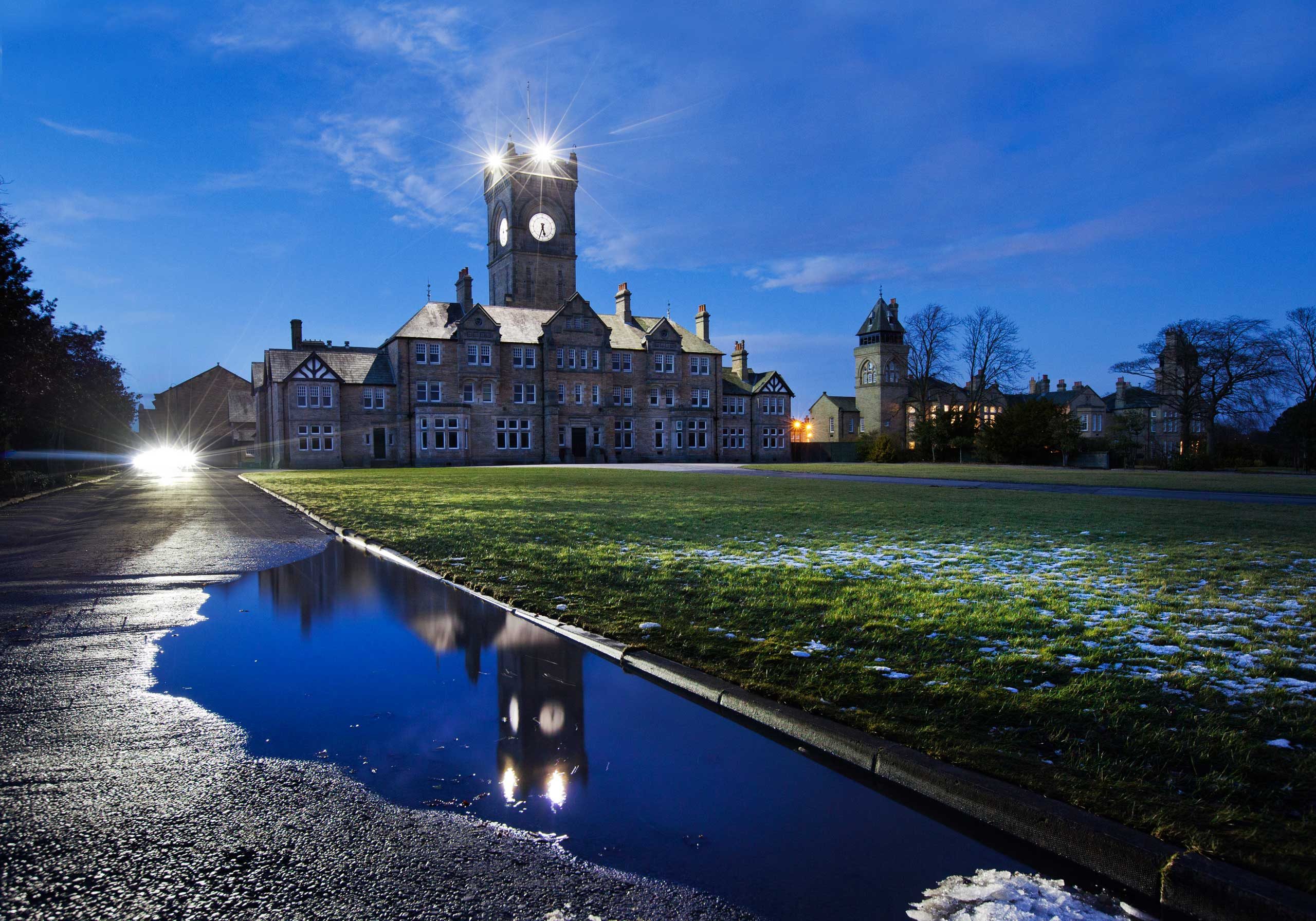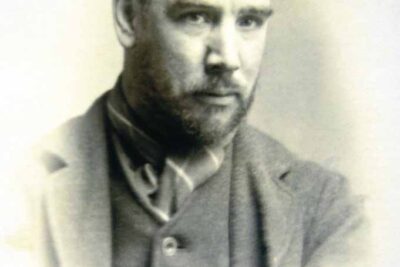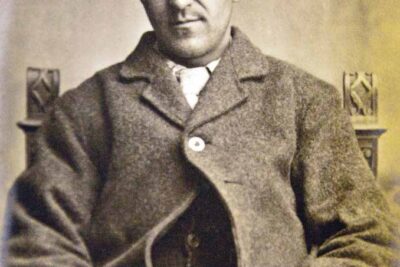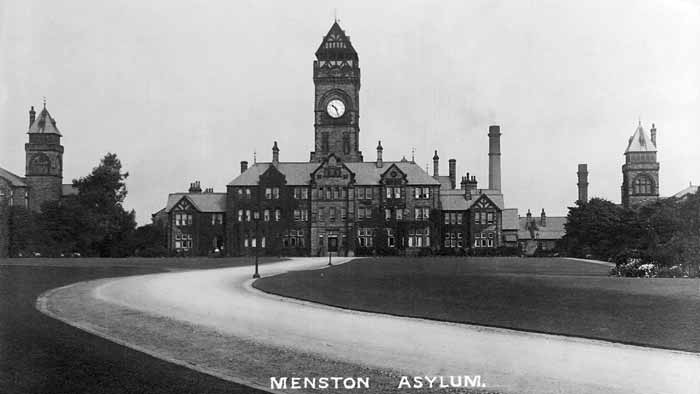
Voices from the asylum | Menston Asylum
by Mark Davis
As a new regular feature in Northern Life we are running fascinating stories of those people who until now were lost in the dusty ancient medical casebooks stored at the West Riding Archive Service at Wakefield. Our photographer Mark Davis is also an author of 11 titles including Voices from the Asylum of which these accounts take us into a world where entering a lunatic asylum often became an arbitrary life sentence.
Menston Pauper Lunatic Asylum (later High Royds Hospital) was the third of the West Yorkshire Pauper Lunatic asylums to open, and important in the pioneering use of the ‘Broad Arrow Echelon’ plan much favoured to provide south-facing aspects to the wards and easily separate the patient classes. It was only the second asylum to be built in England to this design.
The dramatic interior with fine Burmantoft tiles, Italian terrazzo, coloured glass with painted birds and elliptical arches are some of the reasons why Grade II listing has been awarded since its closure in 2003.
This historically important building, which opened in 1888, tells us so much about the Victorians, their immense industrialisation and craftsmanship, bold and sweeping gestures to improve society and their eccentric attention to the finer details of respectability and class. The paradox of harsh judgement, misguided treatments, and moral fervour, juxtaposed against attendants being employed to restrain and entertain, and the magnificent construction of a ballroom, contrasted by the harsh reality of confinement cells.
The voices of ‘the apparent insane’ who were admitted to the former pauper lunatic asylum are for the most preserved in the original medical casebooks catalogued and stored at the West Yorkshire Archive Service.
The study of the history of medicine, and more particularly that of psychiatry, often induces in the contemporary reader an understandable sense of relief that he or she is living in the modern world and not in the past. Yet the accounts of the patients in this, representatives of thousands of people admitted between 1888 (when the asylum opened on 8 October) and 1917 will resonate with all who take an interest in mental health today. Some of the people we meet were paupers who were certified as insane, others became paupers as a result of their mental illness.
James Knott
Things looked bad for James Knott when admitted to Menston in 1904. By all accounts he was stupid, childish and a demented epileptic, the prognosis was distinctly unfavourable. Described as both quiet and tractable yet at the same time violent and dangerous James was going nowhere. Well not until 7 December 1906 when it was noted “this patient along with three others yesterday afternoon escaped from the asylum at about 3.45p.m. he was out exercising in the airing court where he scaled the railings after leaving the urinal where he was in hiding he got away and was absent the whole of the evening and the night.” James was soon recaptured along with his fellow escapees.
Stupid childish demented
The quartet’s remarkable adventure was fully reported in the Bradford Daily Telegraph and is fully transcribed.
Once recaptured James Knott remained at Menston Asylum until his death on April fools’ day 1918. The apparent cause of death was epilepsy; his death certificate was signed by Dr Richard Kirwan. He was buried in the asylum cemetery in an unmarked grave at Buckle Lane, Menston, on 6th April 1918, aged 48.
It is hard to believe that such an apparent demented patient who, if we trust his notes struggled to function on a basic level could in fact make such an escape. If we believe James’s notes to be exaggerated then where does it leave every other patient’s notes.
- Number of Admission: 6578
- Occupation: Stoker
- Chargeable to: North Bierley
- Admitted on the 7th day of March 1904
- Age 33
- Religious Persuasion: Church of England
- Married
- Previous place of abode: North Bierley Union Workhouse, Clayton
- Attack: 1st
- Age on first attack: 33
- Has not been in any asylum.
- Insane: 4 months
- Supposed cause: Not known
- Is epileptic
- Is dangerous to others
- Name and residence of nearest known relative: Mary Knott, Denholme nr Bradford
Facts observed by J Jackson, 5th March 1904: He is stupid and unable to talk coherently especially after an epileptic attack. He is dangerous to other inmates. He has made some attempts to run away from the workhouse.
Mental State: This patient readily engages in conversation and is able to give some account of his past life, but is childish and fatuous in his manner, and exhibits little knowledge of the fitness of things. He gives a history of recent epilepsy and admits that he has no knowledge of his actions about the period of his epileptic attacks. At present he is quiet and tractable and has some limited knowledge of and interest in his surroundings.
- Diagnosis: Dementia
- Cause: Epilepsy
- Prognosis: Not favourable
- Treatment: Nil
- Walter Longbottom
- Charles Tillotson
- Charles Frederick Sutcliffe
Lunatics at large
Bradford Daily Telegraph, December 7th 1906.
During the night, Bingley, Keighley and the surrounding districts have been the scene of an exciting hunt after four escaped lunatics.
The quartet succeeded in gaining liberty from detention at Menston Asylum and made their way through Baildon and Shipley to Bingley.
How they effected their escape is at present a mystery, but it is reported that being quiet patients they were allowed considerable licence whilst at exercise in the grounds late yesterday afternoon.
Finding themselves unobserved they walked away, and once outside the grounds they took to flight, making their destination the Worth Valley, where it is supposed one of the lunatics hails from.
Their escape was soon discovered and warders were immediately sent out to scour the countryside and one of the warders was sent forward on a bicycle to inform the police authorities at Shipley.
Notwithstanding these precautions the fugitives managed to pass through both Baildon and Shipley in daylight, undetected.
This is somewhat strange considering the fact that all the men were dressed in the regulation inmates’ garb, consisting of dark tweed suits branded “Menston Asylum”, shirts and stockings with red bands on the top, and black buckled boots.
On hearing of the matter a “Telegraph” representative ascertained that the men’s names and descriptions were as follows:
James Knott, 35 years of age, five feet nine inches in height and of dark complexion.
Walter Longbottom, 40 years of age, four feet six inches in height, dark hair turning grey.
Charles Tillotson, 26 years of age, five feet six inches in height, dark complexion with slight moustache.
Charles Frederick Sutcliffe, 26 years of age, five feet six inches in height, of light complexion.
After leaving Shipley, the men – who evidently separated – made their way through Nab Wood and along the Bradford Road.
Just before reaching Messrs W R and R Atkinson’s Joinery Works at Bingley, they narrowly escaped capture through the keen observation of Police Constable Hardy. This officer saw a man of diminutive stature – evidently Longbottom – behaving in a suspicious manner. He was ambling along in a peculiar manner, and behaving with pronounced eccentricity. His suspicions aroused, he followed the man and passed close by him at Messrs Atkinsons works.
Longbottom, noticing he was observed, doubled into the road and walked quickly on, re-passing the policeman. On reaching the King’s Head Hotel, the man was joined by another, and the two walked together into Myrtle Place, where they joined two others.
Hardy – who it should be mentioned did not know that lunatics were at large – turned down Myrtle Pace to the Police Station. He looked around, and saw the four men standing by Mr Butterfield’s shop watching him.
Immediately they realised that he had again seen them they made off down Main Street in the direction of Keighley.
The news of the escape from Menston was shortly afterwards conveyed to the police authorities at Bingley, and Hardy who immediately suspicioned the men he had seen as being the persons wanted, set off on a bicycle in the direction of Keighley.
He was assisted by Police constable Mobbs, who proceeded on foot to Sandbeds.
In the meantime the police at Keighley were notified of the approach of the suspected pedestrians, and elaborate arrangements were made to affect their capture by means of a cordon.
Hardy’s efforts to overtake the men was unsuccessful, though it was afterwards ascertained from a Bradford carrier that the fugitives had been seen at Sandbeds.
The men must have had a suspicion that the police authorities at Keighley had been informed of their approach, and they then struck across country in the direction of the Worth Valley.
A keen lookout was maintained by the police throughout the night, and early this morning, three of the escaped men – Knott, Longbottom, and Sutcliffe – were captured at Haworth.
The arrests were made quietly, for the men apparently realised the futility of resistance.
The whereabouts of Tillotson were at the time unknown.
The prisoners were conveyed to the Keighley Police Station where they will be detained until an escort of warders arrives to convey them back to the asylum.
Escapees at the barber’s
‘Amusing Incident at Keighley,’ December 8th 1906, Bradford Daily Telegraph
The report that the four lunatics who escaped from Menston Asylum yesterday sought to evade the police by striking across country from Sandbeds, appears to have been incorrect. They appear to have proceeded via Stockbridge to Keighley.
An amusing incident in connection with their visit is that immediately on arrival in Keighley they went into Turner’s hairdressing rooms near the station and requested the barber to shave them. From the conduct of the men the barber was suspicious, but it was not until shaving the last man that he felt convinced of the insanity of his customers.
He questioned the last man to be shaved as to where he came from, and he was informed that the quartet had walked from Menston that day. “Have you been working there?” inquired the barber, and the reply was: “Yes; working a whole week for three half-ounces of shag; we’re sick of it and we’re determined not to stand it any longer.”
The men then went out of the shop, and proceeded through Keighley. The barber confessed that he was thankful that he had not known the character of his customers from the first, for if they had been at all violent disposed the array of razors might have tempted them.
The man Tillotson is still at large, and it is thought he is somewhere upon the hills overlooking the Worth Valley.
The fourth captured
December 14th 1906, Bradford Daily Telegraph
All the four lunatics who escaped from Menston Asylum have now been accounted for. Three were returned to their quarters on Friday, but the fourth, a man named Tillotson, was not taken till Saturday morning.
He was a native of Oakworth, and the warders and police naturally surmised that he would make for his home. Nor were they surprised, for the house was watched, and Tillotson was seen to approach. He was taken quietly by the warders and removed to Menston Asylum.
Our Menston correspondent writes:
The last of the men who escaped from Menston Asylum, Charles Tillotson, was taken back to the asylum shortly before one o clock on Saturday and they were interviewed
by the doctor of the Asylum. The men were asked the reason why they went away, and they replied that they wanted a day off to see their friends.
They went by way of Baildon, Saltaire and Bingley and Tillotson was standing in front of a newsagent’s shop on Friday at Keighley, and saw a placard announcing that madmen were at large. A policeman came up to him and said: “It’s a bad do about these madmen getting away” and Tillotson replied: “Yes, it is: but I think they will be glad to get back again. I don’t think they will do anyone any harm.”
And the policeman said: “I don’t know so much about that; we want to get hold of them.”
Tillotson then went away and visited several friends in Keighley, and finally went to his mother’s at Oakworth, where he was captured, and was brought back to the Asylum on Saturday morning.
Mark Davis’ book Voices from the Asylum is available to buy from Amazon £14.99










